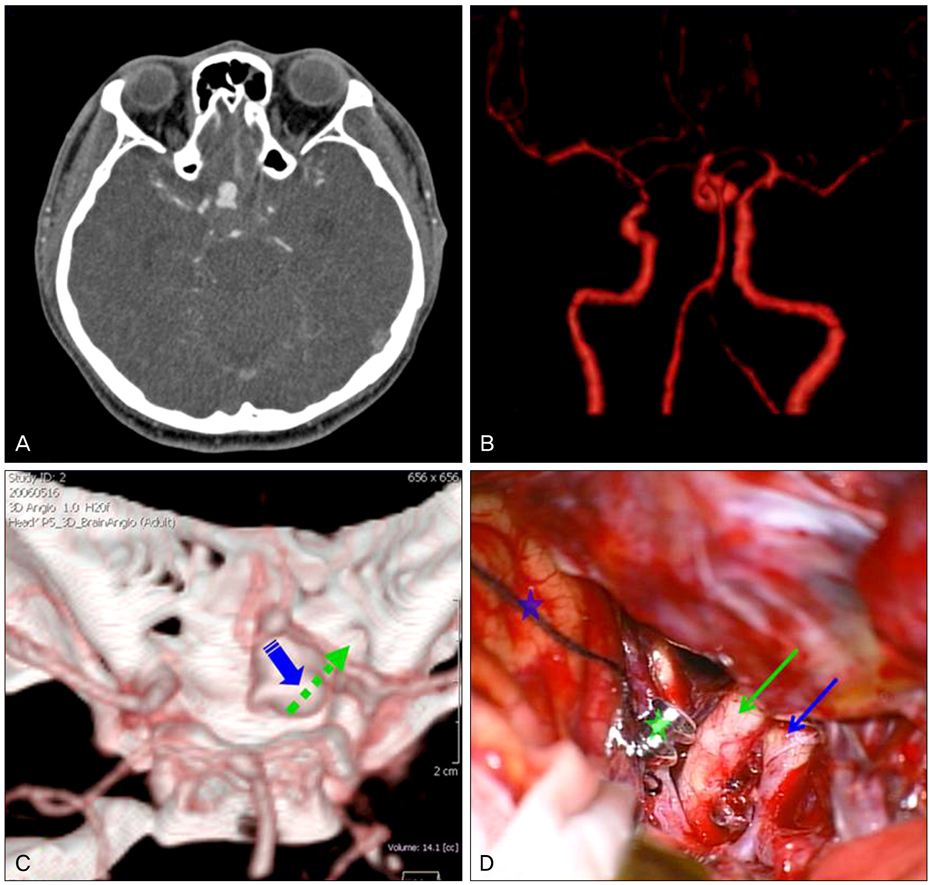Korean J Ophthalmol.
2011 Oct;25(5):366-368. 10.3341/kjo.2011.25.5.366.
Computed Tomographic Angiogram of an Anterior Communicating Artery Aneurysm Causing Acute Retrobulbar Optic Neuropathy: A Case Report
- Affiliations
-
- 1Department of Ophthalmology, Soonchunhyang University Bucheon Hospital, Soonchunhyang University College of Medicine, Bucheon, Korea. yhohn@schbc.ac.kr
- 2Department of Neurosurgery, Soonchunhyang University Bucheon Hospital, Soonchunhyang University College of Medicine, Bucheon, Korea.
- KMID: 1098644
- DOI: http://doi.org/10.3341/kjo.2011.25.5.366
Abstract
- Three-dimensional computed tomographic (3D-CT) angiography is a widespread imaging modality for intracranial vascular lesions. However, 3D-CT angiograms of an anterior communicating artery aneurysm associated with acute retrobulbar optic neuropathy have not been previously described. We present 3D-CT angiograms of an aneurysm of the anterior communicating artery that caused subarachnoid hemorrhage and vision loss in a 39-year old man. The 3D-CT angiograms were consistent with findings identified directly during surgery.
Keyword
MeSH Terms
Figure
Reference
-
1. Lovblad KO, Altrichter S, Viallon M, et al. Neuro-imaging of cerebral ischemic stroke. J Neuroradiol. 2008. 35:197–209.2. Alberico RA, Patel M, Casey S, et al. Evaluation of the circle of Willis with three-dimensional CT angiography in patients with suspected intracranial aneurysms. AJNR Am J Neuroradiol. 1995. 16:1571–1578.3. Thijs V. Imaging techniques for acute ischemic stroke: nice gadgets or essential tools for effective treatment? Neuroradiology. 2010. 52:169–171.4. Craenen G, Brown SM, Freedman KA, et al. Rapid, painless unilateral vision loss in a 37-year-old healthy woman. Surv Ophthalmol. 2004. 49:343–348.5. Chan JW, Hoyt WF, Ellis WG, Gress D. Pathogenesis of acute monocular blindness from leaking anterior communicating artery aneurysms: report of six cases. Neurology. 1997. 48:680–683.6. Hara N, Mukuno K, Ohtaka H, Shimizu K. Ischemic optic neuropathy associated with subarachnoid hemorrhage after rupture of anterior communicating artery aneurysm. Ophthalmologica. 2003. 217:79–84.
- Full Text Links
- Actions
-
Cited
- CITED
-
- Close
- Share
- Similar articles
-
- Blindness Caused by Wrapping of the ICA Aneurysm
- Ischemic Optic Neuropathy in Ruptured Anterior Communicating Artery Aneurysm
- Microsurgical anatomy of the Anterior Cerebral-anterior Communicating Artery
- Failed GDC Embolization for Aneurysms Arising at the Fenestrated Anterior Communicating Artery
- Transposition of Anterior Choroidal Artery and Posterior Communicating Artery Origin


